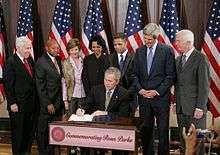Signing ceremony

A signing ceremony is a ceremony in which a bill passed by a legislature is signed (approved) by an executive, thus becoming a law.
History
Modern-day signing ceremonies are derived from ceremonies that occurred when the British monarch gave Royal Assent to acts of Parliament. Signing ceremonies are an aspect of American politics.
Signing ceremonies may be performed by state governors upon signing an act of the state legislature into law or may be performed by the President of the United States upon signing an act of Congress into law. The President often invites leaders from the Congress that were instrumental in the passage of the bill as well as interested members of the community. One practice is to use several pens and honor individuals by giving them the pens used in the signing ceremony. For the signing of the 1964 Civil Rights Act, President Lyndon B. Johnson used more than 75 pens. The pens were then given to attending dignitaries and supporters of the bill, including Rosa Parks, Attorney General Robert F. Kennedy, Hubert Humphrey, Everett McKinley Dirksen and Martin Luther King Jr.
Signing ceremonies are associated with acts that are viewed as legislative triumphs for the executive. Conversely, laws that are passed reluctantly or are controversial are often signed into law quietly and privately without any public ceremony.